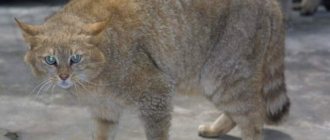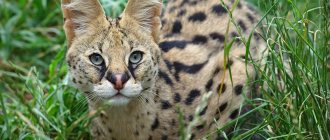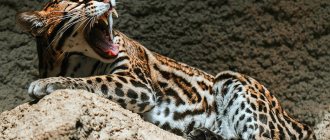The fishing cat or civet cat has recently attracted great interest among exotic lovers. There are also frequent attempts to keep it at home.
It should be remembered that this is not a breed of domestic cat, it is a natural variety of a wild predator. In order for coexistence to be comfortable for everyone, it is necessary to know everything about this rare species.
Keeping a fishing cat at home
In almost all countries of the world, breeding of these large predators is prohibited and special permission is required to keep them in private nurseries.
It is almost impossible to completely domesticate a civet cat. Representatives of this breed have a complex character and in nature they conflict even with their relatives. That is why there is no guarantee that even a kitten that has grown up among people from early childhood will not behave aggressively. Nevertheless, lovers of exotic pets still keep this large predator at home. A fish cat needs a special approach. That is why it is advisable to turn to a professional breeder for help in raising this animal. You need to take a two-month-old kitten of this breed into your home. It is necessary to feed the animal only by hand, so that it quickly gets used to the owner. The kitten must constantly be in the company of people. Some owners place the civet kitten in an enclosure built on the property, but this is not recommended, since this will prevent the pet from getting used to the owner.
Kittens love to play with their owner, but during the fun they may miscalculate their strength and scratch the owner. In such cases, you should not scream or hit your pet, since such behavior by the owner will cause retaliatory aggression in the predatory animal. You just need to tell the fishing cat “no” in a stern voice and leave him alone for a while. Fishing cats are very smart and will understand that they have offended their owner.
In nature, civet cats live in groups, but in the house they consider all members of the household to be their pack and demand attention from them. At the age of two, pets begin puberty; during this period, they cause a lot of trouble for the owner. The animal begins to actively mark its territory, and the males even protect the “females,” in the role of women living with him in the house, from male household members. Castration of the predator, which is recommended before the age of 8 months, will help get rid of the first problem, but the second one is almost impossible to solve. If owners are faced with such a situation, then, as a rule, the predator has to be sent to a nursery.
Rules for keeping a cat at home
Every year there are more and more nurseries for breeding civet fishing cats, and professional breeders are not afraid of the difficulties in obtaining permission to raise these exotic animals. Exotic lovers should purchase animals only from one of these nurseries. And after you have adopted a kitten, follow a number of rules for its care.
The ideal age for a kitten to be placed in a home is two months. As soon as the kitten was brought into the house, from the very first days of its life it must be fed by hand, so that it gets used to both the new home and its owner. The kitten should be with people all the time. Often people who have houses outside the city set up something like an enclosure on their property and place a kitten there. In this case, the animal will never truly get used to people and, alas, will not become pets.
The civet fishing cat, like any domestic animal, expects attention and affection from its owner. He also loves to play madly, but, being carried away by the gameplay, he may, without meaning to, scratch or even bite his owner. Under no circumstances should a cat be scolded, let alone beaten for this, because he will immediately defend himself. It is enough to simply strictly tell the cat “no” and blow in his face - cats cannot stand this. If the animal has done something wrong, then you need to leave it completely alone, for example, lock it in a room. A cat of this breed will quickly understand that the owner is offended by him, as this is a very smart animal.
The biggest problems begin with the onset of puberty in the civet fishing cat. We are talking about 2–3 years. The first sign of a male maturing is that he marks his territory, considering it his property. If the cat will not participate in breeding, it is best to neuter him before reaching eight months of age.
Since a fishing cat lives in a flock in its natural habitat, even when at home it will consider all family members to be its flock and demand attention from all people living in the house.
There is a known case when a civet fishing cat, having become an adult male, began to protect the “females”, i.e. the women living in the house, considering them his pack, from his owner - the “male” in the opinion of the cat. And the family had to give him to the zoo, although they really didn’t want to do this.
That's why it's best to get a regular house cat at home. Even if the family prefers large cats, you can find a pet of a breed whose representatives can reach a fairly large size.
Who else isn't afraid of water?
In fact, the civet cat is not the only one who loves to swim. For example, he is also not averse to frolicking in the bathroom with the owner. The Kurilian Bobtail, Turkish Van and African Soukok can confidently be included in this category of swimming fluffies.
For a striking example of a fishing cat hunting, watch the video:
KotoDigest
Thank you for subscribing, check your inbox: you should receive an email asking you to confirm your subscription
The Internet is replete with funny photos and videos about how cats don’t like to bathe. Meanwhile, there is a family that not only loves to swim and swims well, but most often obtains food in the water.
These wild cats are called by many names: fish cat, fishing cat, speckled cat, fishing cat. In Latin, the name of the species is Prionalurus viveirrinus ,
which is understandable, because Both in appearance and in name, the speckled cat resembles a civet (in Latin viverra).
The color of the fishing cat's coat is brownish-gray, the stripes on the head are replaced by spots on the body. The color of the fish cat provides maximum camouflage in the coastal mangroves of Southeast Asia, where it lives in tropical and subtropical forests at altitudes of up to 1,500 meters above sea level.
In order for the civet cat to easily dive and swim, its ears are small and low-set, the bridge of the nose is almost absent, the tail is short and thick, and there are webbed feet.
Wild civet cats are twice the size of their average domestic relatives, and males are larger than females.
The fish cat's diet mainly consists of fish, but it can also eat all small animals that fly, jump and crawl near water bodies. Sometimes the fish cat attacks domestic animals and birds.
The fishing cat can climb trees, but does not like to do it. The fish cat is more willing to walk in shallow water and swim. Viverrid cats, like most cats, are individualists, leading an isolated lifestyle and controlling their territory.
The civet fishing cat is listed in the Red Book and one of the main problems threatening its existence is the destruction by people of its habitual habitats. By the way, a similar problem is typical for the habitats of the Australian panda.
In captivity, male civet fishing cats help the female take care of her kittens (however, it is unknown whether they behave as gentlemanly in the wild...). Female fishing cats can become pregnant and bear offspring year-round. There are usually two or three blind kittens in a litter; after a couple of weeks they begin to see, and become adults after nine months.
In the wild, a fish cat tries not to meet a person, although his character cannot be called timid. Rather, on the contrary, the civet fishing cat is considered pugnacious and often conflicts with its neighbors. This, however, does not prevent young animals from being domesticated and tamed. Sometimes civet cats fish, and sometimes together with ordinary cats, but this is quite a risky business. After all, a fishing cat is a wild cat, not a domestic cat!
Although at the zoo, watching speckled cats and kittens is no less interesting than admiring our usual furry pets.
The civet fishing cat, also known as the speckled or fish cat, lives in Southeast Asia. Outwardly similar to other wild cats, but differs from them in its unusual lifestyle, habits and diet. The civet cat can often be found in zoos; it is not suitable as a pet for a number of reasons.
The civet fishing cat lives in tropical and subtropical regions of Southeast Asia, in Southeast India, Indochina, Sumatra, Ceylon, Java and Bali. Not to be confused with, which differs from the civet both in appearance and way of life. Fish cats settle near reservoirs, lakes, swamps and slow rivers, in general, wherever they can find food and not be seen by humans. An adult civet cat occupies a territory of 4-8 km2, the territory of males can reach 22 km2.
Fishing cats breed all year round. Pregnancy lasts 63-70 days. Litters are not numerous, usually 2-3 kittens are born. At 4.5 months, the young animals switch to adult food, and by 9 months they catch up with the size of their parents and switch to self-sufficiency. Reaches sexual maturity much later, at 2-3 years. In captivity, males help the female raise offspring; how they behave in the wild is not known for certain. And the rest of the way of life of civets has not been studied well enough.
Video about civet fishing cats:
Features of character and lifestyle
The fisherman cat can be quite aggressive towards other members of the species. In this way he protects his territory and hunting grounds. It is worth noting that these are quite secretive representatives of the cat family that lead a solitary lifestyle.
During mating, animals gather in pairs - this can happen at any time of the year, since they do not have a specific season for prolongation of the genus. But still, more often this happens either in the last winter months, or vice versa - at the beginning of summer.
The fishing kitten, like babies of other species, is quite playful and inquisitive. But their freedom, in the early stages, is limited by the mother, who carefully looks after them, preventing external threats to the life of her offspring.
Fact! In captivity, an interesting feature of this animal species was discovered - males help females in caring for babies. They are caring fathers who also teach their kittens to hunt.
It is very unusual that the cat prefers marshy areas and willingly dives into water. It is these behavioral features that determine the fact that the animal is quite active and successful in hunting not only fish, but also aquatic bird species. To do this, the water cat lowers itself completely into the water. It dives and surfaces directly under the bird, grabbing it with sharp teeth and claws.
Cat fisherman while swimming
In addition, the diet includes various types of mammals. Despite their compact size compared to large cats, they are capable of hunting young sheep, deer, calves, and tiger cubs. Capable of dragging a small dog out of the yard.
Trowel.zh.rf
Want to know everything
But we have already studied a lot of wild cats! How can you not remember? I’m telling you exactly what it was, look here:
There is such an amazing exotic cat - the Asian fish cat, also known as the fishing cat, or vivverina. This cat lives and feeds near water. She is not afraid of water, swims well and is said to be able to dive to catch fish.
Felis viverrinus belongs to the class of mammals, order - carnivores, family - felines; lives in Southeast Asia in small areas of India, China, Vietnam, Thailand, Sumatra and Java.
The cat got its name because of its amazing ability to hunt in water. The uniqueness of the fishing cat is that all representatives of the cat family do not like and are afraid of water, but for the Asian fishing cat, water is its native element.
This cat lives and feeds near water. She is not afraid of water, swims well and is said to be able to dive to catch fish. Loves wet, marshy places near rivers and streams.
An adult male weighs from 11 to 15 kg, females are much smaller - 6-7 kg. The body length of an adult cat is 95.0-120.0 cm, the height at the withers is 38.0-40.0 cm. It has a strong build and great strength. The muzzle is short and wide; the ears are small, round, set low on the sides of the head; The jaw is round, the lower one is very strong, equipped with sharp teeth. The animal's head is round, set on a short neck. The fishing cat has short legs and a short and thick tail.
The cat's color is grayish-brown with speckled black, and there are black spots behind the ears. On the upper part of the body, the spots are located along the body, on the lower part - across. The end of the tail is dark. The forehead is decorated with longitudinal stripes or rows of spots.
There are membranes between the toes of the front paws that help the cat catch fish. During a hunt, a cat sits on the river bank and patiently waits for a fish to swim past. The fishing cat will never miss its prey: it hits the fish with its clawed paw and firmly places it on its claws as if on hooks. Sometimes this cat even dives to the bottom of the river for prey. Fish is a favorite food for this cat, but the cat does not disdain other foods: it also eats frogs, snakes, snails, birds, small mammals and carrion.
Fish cats breed all year round. Pregnancy in a female lasts 2-2.5 months, after which she usually gives birth to 2-3 kittens. After 9 months, kittens become adults. Males kept in captivity help the female care for the offspring, but how they behave in the wild is unknown.
The cat eats mainly fish. It also hunts toads, frogs, crustaceans, snakes, small mammals and birds. They can attack poultry, dogs, goats, and calves. It catches fish during daylight hours; at dusk and at night it can hunt for other prey. While fishing, a fishing cat sits on the bank of a stream or river and waits for fish to swim past, and when it does, it sharply hits the prey with its clawed paw.
The civet cat fisher can climb trees, but he does it reluctantly and does not like it. Loves to walk in shallow water and is a good swimmer. When swimming, it uses its short tail as a rudder. The fishing cat, like many cats, leads a solitary lifestyle. Each animal has its own individual territory.
Fishing cats have a reputation for being bullies and fighters, but they try to avoid meeting people. A case is described when one wiverina dispersed a pack of dogs. In some regions of Asia, there is a myth that a fish cat stole a newborn child from Singapore, however, this case is not documented. However, an interesting true fact is that a male fish cat kept in the zoo, a very large specimen, broke out of his cage and, entering the leopard’s cage, killed him.
Fishing cats caught at a young age are well tamed and become attached to people. The local population persecutes those cats who steal their poultry and devastate their fish stocks. The meat and skin of wiverin are used by Aboriginal people in folk medicine to prepare medicines.
There are two recognized species of fishing cat. The species found in Sri Lanka and along the entire coast of South and Southeast Asia down to Malacca and Sumatra are larger animals. Smaller representatives of the species live in Java and Bali.
The fishing cat is a rare animal listed in the International Red Book and the CITES Convention (Appendix II). The total population size does not exceed 10,000 mature individuals. Threats to the species: destruction of wetlands, poaching, pesticide pollution of rice fields. There are two recognized species of fishing cat (Felis viverrina), which differ in size: C. v. viverrinus - India, southern eastern Asia and Sumatra, S. v. risophores - Java and Bali.
Cat health and behavioral characteristics
The Serval cat breed has excellent health, so with proper care, such a pet will live with you for 10-15 years.
- The owner must ensure that the Serval kitten does not jump from a height. At a young age, such pets have fragile limbs, so when jumping from a height, there is a risk of injury to their legs.
- Monitor your pet's stool. If he has diarrhea for several days in a row, and the food has not been changed, you need to sound the alarm and contact a veterinarian.
- Like all other cats, Servals will need to be vaccinated regularly. The vaccines used must not contain active viruses. Otherwise, there is a risk of death of the animal.
- Castration is vital for a pet. The fact is that adult cats of this breed can mark their territory up to 50 times per hour. Moreover, the liquid has an extremely unpleasant odor. Therefore, sterilization and castration is mandatory. In cats, this procedure is recommended to be carried out at 7-8 months, and for cats no more than 1 year old.
- The serval will need space for its active play. It would also be a good idea to take such a pet on a leash outside, where it can jump and run around in the open air.
- These cats have developed intelligence and are easy to train. Therefore, try to raise your pet from early childhood, not allowing it to chew furniture, jump on tables or sleep on the bed.
Interesting solutions for placing a toilet
Picture 10 Cabinet house: takes up a lot of space, but it's worth it
Oh, this ubiquitous cat litter... It seems like the sides are high and the rug is laid out - no, the cat still manages to carry grains of sand to the master bedroom. Owners of spacious apartments and private houses are lucky in this regard - they will be helped out by special furniture, inside of which you can hide a toilet for cats.
The biggest advantage of this design is a separate “room” with a regular rug on which the filling remains.
Even those cats that are taken to the country for several months a year prefer to relieve themselves in a convenient and clean litter box rather than on the street. Today, there are many different models of cat litter available in stores. When choosing one option or another, you need to make sure that it is first and foremost comfortable for the cat.
Life of a long-tailed cat in captivity
Margai is a wild beast, although he has a cute appearance. Such animals have clearly developed appropriate behavior, so they are not adapted to home life. Any small animal in the house will definitely become margay’s prey. Even a small dog can suffer from the claws and teeth of a wild cat. Therefore, representatives of the species living in captivity can be found in zoos.
To properly raise a margay, it must be adopted at an early age.
Features of caring for a predator
Of course, the main requirements for keeping a wild cat are safety measures. All windows and doors must be protected with metal mesh. This will protect not only the owner of the house and his children, but also the cat itself. The animal may leave home and not return. If we are talking about cool regions of Russia, then the animal faces almost one hundred percent death from hypothermia in the first autumn. If we are talking about a relatively warm and humid climate, then in the courtyard of the house you can install a special enclosure covered with a high mesh. However, even in such an enclosure you need a warm house for the cat. In the absence of a house, the cat will have to be brought home at night.
If margay is raised correctly, he can go into your arms
Such a cat needs to be fed meat with small bones (beef, chicken, feed mice and offal). Such food is very similar to prey that a cat could catch in the wild. In addition, the cat needs to be given vitamins and special supplements. Usually people who dare to purchase such an exotic pet communicate closely with veterinarians. Only special skills and knowledge of animal medicine will allow you to raise and educate a wonderful cat.
Video: Margay named Maya eats meat
There have been cases when long-tailed cats lived their entire lives next to humans. True, the behavior of such an animal is more similar to the behavior of a dog. A tamed margay fussily stomps on its owner’s chest and licks his face. I heard that wild cats can even protect their owner and growl at offenders if there is any threat from them.
Habitat of the Margay cat
Margays inhabit almost all warm jungle areas of America (Panama, Ecuador, Guyana, Uruguay, Peru, Argentina). Most long-tailed margays live in central America.
Most margays live in different areas of Mexico, Ecuador and Brazil
The role of the long-tailed cat in the ecosystem
Due to the rarity of the species, it is impossible to reliably establish the role of margay in the ecosystem. However, like any other predator, the long-tailed cat affects the population of small mammals. Margai will not be able to destroy large numbers, for example, of squirrels, since the predator is quite loyal to its prey. A cat can survive without encountering squirrels at all.
The main role of margay in the ecosystem is to exterminate rodents
Appearance of a civet fishing cat
The size of this rare large cat is quite respectable, although they are inferior in weight to such representatives of the cat family as the leopard and panther.
However, with a weight reaching 15 kg for an adult male, and 10 kg for a cat, civet fishing cats can rightfully be classified as large predators. External features:
- The length of its body
together with the tail reaches 1.2 meters, while the tail, of the same thickness from base to tip, accounts for no more than 1/4 of the cat’s total length. At first glance at the muscular, squat body of the fishing cat, it becomes clear that this is a real hunter. - A large and wide head
, with a slightly elongated muzzle, is crowned with small, movable, rounded ears. Large eyes with a vertical pupil look at the world around them warily, but in their gaze it is clear that the fishing cat is confident in his strength. Nature has endowed cats of this breed with large and strong paws, which gives them the opportunity to successfully defeat even larger opponents. - The fur
of viverrid cats is olive-gray in color, with black stripes and spots arranged in a row. The matte shade of the coat helps the animal become invisible among the thickets of plants. The tail is also decorated with black stripes, and the same longitudinal stripes decorate the forehead and scruff of the fishing cat. - The main difference between this breed and other cats is the unusual shape of the nose
. With almost complete absence of the bridge of the nose, it is extremely large and wide. None of the cat breeds – neither small nor the largest – can boast of a nose of such width. This nose structure allows the fishing cat to feel comfortable in the water when swimming and diving. He knows how to hold his breath after taking a deep breath, and water does not get into his nose.
Fossa (lat. Cryptoprocta ferox)
Endemic to the island of Madagascar and its largest predator, the only modern representative of the genus Cryptoprocta.
The classification of this unusual animal is quite complicated; scientists could not finally decide which family it belongs to. For a long time, the Fossa was classified as a cat, then the emphasis changed towards the civet family of the felid suborder. Only a genetic analysis made it possible to solve this dilemma, according to the results of which the species was placed in a separate family of Madagascar civets.
Fossa in an aggressive stance. Photo: hakoar
One way or another, the Fossa is a very close relative of cats. Moreover, Fossa is very similar in appearance and lifestyle to Proailurus, a predator that was the common ancestor of all cat-like animals.
In appearance, the Fossa is similar to the South American jaguarundi and puma. The dense, elongated body reaches 80 cm in length, weighing about 10 kg. A very long and massive tail helps to balance well while climbing trees. Powerful paws of medium length are armed with semi-extendable claws.
Fossas spend most of their time in trees. Their paws and tail are designed in such a way that they allow them to easily move from branch to branch, feeling comfortable even in the thin crowns of trees. Thanks to its tenacious sharp claws, this predator can descend from a tree head down. In a word, this is their element.
Fossa resting on a tree. Photo: David Cook
Fossa's extraordinary ability to climb trees determined the basis of their diet - lemurs. When hunting on land, a predator does not disdain its prey; these can be mammals, birds, reptiles, amphibians and even insects. It is particularly bloodthirsty - it often kills more prey than it can eat.
Family ties with cats can also be traced in the voice of the Foss: kittens purr just like domestic animals, and adult animals growl and meow protractedly when threatened.
Domestic fishing cat - what is its price?
The character of the fishing cat leaves much to be desired. This is a freedom-loving animal. He often comes into conflict with his relatives and other forest inhabitants, and even with humans. However, there are cases of these cats being domesticated and living together with people in the same house, although this of course comes with risks.
In the photo you can see a fisherman playing with an ordinary domestic cat. They are seen to coexist peacefully with each other. Not a single cat was harmed as a result of the experiment.
The same cannot be said about the fish that was thrown into the bathtub, and our cat happily rushed to swim into his native water element. Well, the bathroom is certainly not mangrove forests, but still...
Viverrid fishing cat (Prionailurus viverrinus)
- a species of medium-sized wild cat from the cat family
(Felidae)
, genus oriental cats
(Prionailurus)
.
Exterior data
Fishing cats are quite large animals: the size of a dog, about 40 centimeters at the withers, weighing up to 15 kg (females are smaller, about 7 kg).
The length of the body is about a meter. Fit and muscular, they have the grace and swiftness of a leopard and great strength. Their muzzle is short and wide, which makes them even more impressive. The ears are small and round, pressed to the head - demonstrating aggression. The jaws are very strong, which is why these animals are called the pit bulls of the cat world.
The head is large, almost merges with the body due to the short neck. The legs and tail are short and thick. The fur is short and coarse, waterproof. Fishing cats have another remarkable feature: they have membranes between their paws that help them hunt in the water. They prevent you from retracting your claws, but they help a lot when fishing.
Binturong
Binturong
Another name for it is “cat bear”. It is very true, since outwardly this animal really resembles both a bear and a cat. From the bear, the binturong took a clubbed gait, a clumsy body, short legs, dark, coarse fur and rather large dimensions. Body length - from 60 to 90 cm, plus a tail of the same size (if not larger), weight - from 12 to 20 kg. What stands out in his appearance is his almost white mustache and dashing tufts on his ears. It is clear that these are no longer bearish signs.
Best articles: Limnology - the science of lakes and other inland waters
Binturongs are common in tropical forests of Asia. These are nocturnal animals that swim, dive and climb trees well. True, the heavy binturongs cannot jump, but they have a very tenacious tail, thanks to which they maneuver among the branches. They feed on small rodents, birds, fish and carrion.
Binturongs are calm, lazy, non-aggressive, trusting animals that some people decide to keep at home. Why someone? Yes, because these cat bears have one unpleasant quality - they pee everywhere and very often, since nature has endowed them with uncontrollable urination. In some countries, binturong meat is a real delicacy.
Viverrid fishing cat
How is my passenger doing, they say? Then, taking a deep breath and pressing his ears to prevent water from getting in, Dekha makes the first dive. This is not yet a deadly throw, it is he who, for his own pleasure, drives the prey to the other end of the bathtub. Having followed the catfish into the bathtub from end to end, Deha repeats this simple operation a couple of times, but then, apparently unable to withstand the temptation, he dives masterfully, unerringly grabs it and appears on the surface with the catfish in his teeth. He clearly knows the hierarchy in the family . Mom is a mother, you need to love her, obey her, but you don’t have to be too afraid. We must first see if she is really that angry. Maybe he's joking. I am a dominant cat. You need to be afraid of me, definitely obey me, but it is advisable to be rude and hiss on occasion. And of course, show in every possible way that you yourself are already big and mature and spat on me from a high TV tower. Masya is the best friend, mother, nanny, all rolled into one. We love madly, but love is sometimes rough. Playmate. The most interesting thing is that it is in the game, in Deha’s struggle, that there is delicacy itself. Never bites or scratches. Realizes his strength. Again, only with Masya. With the same mother, it can be exactly the opposite
“Masya is small and weak, you have to be careful not to hurt him. Mom is so healthy, what will happen to her? I need to give it properly so that she can see how strong I am.” For the first time, at four months, we took him to Tatyshev Island.
And away from water and trees. When we arrived on the island, for safety reasons we stood in the middle of an open field, thinking that suddenly it would rush somewhere, at home it flies like a Ferrari. In vain. The whole collective farm scooped him out of the car. Immediately, half-crawling, he moved under Masya and did not crawl out of the shelter for some time. He sat, concentratedly sniffed and looked out, now from under one paw, now from under the other. Masya just got up and walked. Do you think Davis is staying? No matter how it was, he also went, but under Masya’s belly. ...I actually saw a civet mother leading her children out of the den for the first time. How does he know all this? Then, having become somewhat accustomed, he began to make gentle, zigzag raids a little to the side. He would go half a meter deep into the grass, run a meter along the side of the road and again dive under Masya. After some time, he simply changed his shelter and disappeared into the grass. We immediately realized that we had to keep our eyes open here. Despite the fact that the child is absolutely not green, he surprisingly knows how to blend in with the grass. "
“Unfortunately, Deha left us. He went to his tribe. We must believe people, experts told us that a wild animal cannot become completely domesticated. Don’t be arrogant, we tried hard, you won’t succeed either. You CANNOT keep wild animals in your apartment!”
“Everyone should live in his own flock” - this Kipling law is unshakable. (With)
https://usatiki.ru/viverrovyj-kot-rybolov/https://porodakoshek.ru/porody/dikie-pyatnistye-koshki-viverrovyj-kot-rybolov-harakteristiki-i-opisanie.htmlhttps://pikabu.ru/ story/viverrovyiy_kotryibolov_564322
History of the discovery of the variety
Fishing cats have been known to the indigenous populations of many Asian countries since ancient times. These animals preferred to hide in the thickets of the tropical jungle during the day, so for a long time there were only legends about the ghost cat.
During the development of new territories, extensive deforestation and drainage of wetlands began. Viverrid cats had to adapt to new living conditions; they became more noticeable to people and, unfortunately, became objects of hunting.
Local healers consider almost all parts of the animal’s body valuable, from which they brew numerous potions.
Hunters continue to catch civet kittens for sale, despite the fact that in most countries in the animal's natural range, these actions are punishable by law.
The name of the species was given by the English zoologist and writer Edward Turner Bennett in 1833, having described in detail the morphology and color of the cat, which in India was called “fishing cat”.
In 1958, the name Prionailurus was proposed to the new species by the Russian researcher and naturalist Nikolai Severtsev as a common name for the spotted cat species of Asia, and the name Felis viverrinus rhizophoreus was given by the Dutch scientist Henri Jacob Victor Sodi in 1936. He described in detail the Viverrid cat caught on the coast of West Java. This individual has a slightly shorter skull than specimens previously found in Thailand.
Today, the unique animal has many names - Viverrid, Speckled, Fish, Fisherman, Asian fish cat, Fish cat.
The name Speckled is associated with the fur pattern - the cat's entire body is covered with dark specks.
Viverrid means similar to the tropical predatory mammal civet or civet, mainly due to its secretive lifestyle. The cat is called a fisherman due to its preferences in hunting, fishing and nutrition.
The names of the predator in local dialects are also interesting. In Assamese it is Meseka (fish), in Bengali it is Maha-bagrol or Bagh-Dasha. Maha means fish and Bagha means tiger. In Hindi, the name of the Fishing Cat sounds like Ban-Biral, in Telugu - Bavuru-pilly (wild cat), in Sinhala - Handun Divya, in Thai - Sea-Pla (fish tiger). In Myanmar, this predator is called Kuanga-ta-nga. "Kuanga" means "cat" and "ta-nga" means "fisherman".
Life of wild forest cats in nature
Forest cats have a wide distribution area and are found in Europe, Africa, along the shores of the Sea of Japan, in the jungles of India, the steppes of Turkestan, the mountains of Scotland and the Caucasus.
You can still find a lot of wild cats in the Scottish mountains
These animals prefer to settle in deep forests, where people rarely visit. Therefore, it is rare to discover the wild ancestors of domestic purrs. Mountain clefts and deserted shores of reservoirs become favorite places for forest cats to live.
These small predators can choose abandoned fox or badger holes, empty tree hollows, and even uninhabited nests of large wading birds as shelter.
The territory occupied by one animal is about 2 hectares in size. Boundaries are marked with the help of odorous anal secretion, with which males carefully irrigate trees and shrubs. An irreconcilable war is waged for each plot, especially during the mating season.
It is also interesting that wild cats do not like areas where there is a lot of snow. After all, under the abundant snow cover, it is difficult for small animals to get food. Therefore, in especially snowy winters, purrs walking on their own can be found near a person’s home. This is how forest cats try to survive, because people always have food.
Peculiarities of behavior of forest cats
Since these representatives of the cat family are wild predators, the cats have a corresponding disposition. Animals love freedom and fiercely defend their independence.
Forest cats are skilled and dexterous hunters
Wild forest cats are loners, leading a secretive lifestyle. The animals quickly and easily evade pursuit, hiding in gorges or on treetops. They lead a nocturnal lifestyle, but do not shy away from hunting in the daytime.
Any small animal that can be caught can serve as prey for forest purrs. These can be rats, nutria, as well as hares or squirrels. A wild cat will not refuse to catch waterfowl, fish, and even crayfish. And in arid regions, insects, snakes and lizards become victims of tailed animals.
The method of attack of forest cats is similar to the hunting methods of other representatives of the species - predators catch prey in a jump, sometimes reaching a length of three to five meters.
To hear even a “word” from a wild forest hunter, you need to greatly anger the animal. And then the animal will make hissing, howling or even whistling sounds. And the meowing typical of cats can only be heard during mating dances and the search for a partner.
Procreation issues
For most of the year, wild forest cats prefer to avoid the company of even their own kind. However, with the onset of cold weather in January, males begin to gather in small groups and look for females for mating until the end of March.
Wild forest cats give birth to up to five kittens in one litter
If two cats develop a liking for the same cat, fights with characteristic fights and warlike cries arise between the furry “knights.”
It also happens that forest males choose domestic females as partners, and then the latter give birth to wild and wayward kittens.
Pregnancy in wild forest cats lasts 62–67 days, after which blind kittens are born. The eyes open only 9–12 days after birth. One litter usually produces five cubs, but there may also be one kitten. Or, on the contrary, the brood turns out to be numerous - up to seven heads.
Shortly before giving birth, the female finds a secluded place from which she makes a safe den. Kittens will grow up in this shelter until they are four months old. The mother cat feeds her cubs with breast milk for the same amount of time.
The level of safety decreases when the grown offspring begins to leave the den on their own - at one and a half to two months of age. And then martens and foxes will pose a threat to the life of the young animals.
At two months, young forest seals begin to go hunting, accompanied by a cat, and at five months they enter adulthood. Males begin to explore new lands, while females remain in the maternal area.
Forest purrs live for quite a long time - up to 15 years. However, young animals often die before reaching 10 years of age.
And if there are no threats in the form of large predators, then life expectancy increases up to 30 years of age. Such situations arise, among other things, when animals enter a person’s home.
Wild European cat in captivity
The European wild forest cat is tamed with great difficulty, and it is very difficult to keep it in captivity. The animal finds enclosed spaces extremely difficult. The genetically inherent wildness and independence cannot be overcome by training and education. However, many zoos around the world keep these animals, where they successfully breed.
Keeping a wild European cat at home is very difficult
From personal observations. Once upon a time, a wild kitten came into our house. He was picked up by a compassionate hunter he knew in the forest. The animal looked to be 5–6 months old. He hid under the closet, hissed and purred incessantly, and refused to eat. There was no question of picking it up. Sharp claws and teeth made the kitten dangerous to others. For about two weeks we tried to tame him, but everything was useless and the baby remained completely wild. During this time he lost a lot of weight and began to look bad. I had to return him to the bosom of nature.
Features of maintenance and care
It is hardly possible to keep a purebred cat in an apartment, because it is extremely uncomfortable for a predator to live there. Urban conditions are absolutely unsuitable for this animal. Kittens born in the wild inherit predatory instincts and a wary attitude towards people from their wild mother. A wild animal, adapted to natural conditions, requires some freedom and significant space to move. Therefore, a private household with the possibility of keeping a cat in a spacious enclosure is more suitable.
It is recommended to purchase small kittens (no older than 2–4 months) from professional breeders who have kept several generations of domesticated wild animals. In this case, the cat can be tamed. But she will still have an extremely freedom-loving, independent, and independent character and will never be affectionate. Babies born in captivity get used to humans from the very first days of life. Predatory habits become a little duller, animals accept food from humans, become more sociable and respond to affection.
It is recommended to purchase kittens from professional breeders
The diet of a wild European cat should be as close to natural as possible. His diet includes the following products:
- lean meat (beef, chicken, rabbit, etc.);
- dairy products;
- River fish;
- offal (liver, heart, lungs, etc.);
- eggs.
It is necessary to give your pet vitamin and mineral complexes. Animals are very fond of young cat grass and oat sprouts.
The diet of wild cats in captivity must be balanced
Proper care for these predators includes regular vaccinations, taking anthelmintic medications, trimming their claws, and cleaning their eyes and ears. It is necessary to take care of flea control agents (drops on the withers, collars, etc.). It is necessary to constantly comb the fur, especially during the molting period.
Life expectancy and health
Genetically, the wild European cat has excellent health and strong immunity. However, with poor nutrition and poor living conditions, animals are susceptible to several diseases:
- Polycystic kidney disease. Multiple cystic formations in the renal pelvis, causing disruption of the urinary system.
- Glycogenosis. A very rare hereditary pathology caused by a lack of special enzymes. Kittens die in the first months of life.
- Hypertrophic cardiomyopathy. Pathology of the cardiovascular system, inherited.
- Retinal dysplasia. Causes decreased vision.
With good care, the lifespan of a forest cat in captivity reaches 30 years, which significantly exceeds the lifespan in natural conditions.
Description of the fishing cat
Like most wild predators, the appearance, habits and character of a fishing cat are entirely dependent on natural conditions. After all, hunting for prey is a process on which the life of a cat and its offspring depends, so it is necessary to have a coloring that is consistent with the general nature and a strong body.
The animal swims and dives well in search of prey
External data
An adult civet fishing cat weighs up to 15 kg. The body can be from 96 to 120 cm in length, and the height at the withers can be from 38 to 40 cm. Moreover, cats are twice lighter and smaller than males.
The animals have a strong physique, characteristic of all representatives of the cat family. At the same time, the following external signs are considered to be the distinctive features of a fishing cat:
- short skull shape;
- practically absent bridge of the nose;
- round and very powerful jaw;
- ears are small and round in shape;
- short thick neck;
- short legs;
- shortened tail length;
- Webbing on the front paws between the toes.
The color allows the cat to remain invisible against the backdrop of wild nature.
The color of the civet fishing cat is standard: the skin is grayish-brown with black spots. The fur is thick, short, and has waterproof properties. The skin has a matte finish, which allows the angler to blend into the environment.
On land, the cat moves somewhat awkwardly, trying to cling to the ground. The tail is used for balancing while walking and swimming. It has the same thickness throughout its entire length, and in all cats it is necessarily striped.
Character
The civet cat has the typical character of a predator. Typically, the female occupies a territory of up to 8 km². This space is enough for her not only to hunt, but also to feel safe for her cubs. An adult male fishing cat defends his rights to a much larger area - about 22 km².
Among the natives, fishermen have long been known as bullies and brawlers, although they avoid meeting people. Cats conflict not only with other animals, but also with each other if a stranger has violated the boundaries of someone’s territory. This is perhaps the most important quality in their character.
Since zoological observations of fishing cats are very rare, and they are practically not kept in captivity, little is also known about the nature of the animals. The fisherman is very handsome and unusual in appearance, but his attractive appearance is in no way associated with the temperament of a serious killer cat.
The image of a “cute cat” does not fit in with the character of a cunning and strong predator
Habitat
Viverrid fishing cats can be found in the tropics or subtropics. Therefore, they are accustomed to hot climates and have never seen snow. The optimal temperature for these cats is 25–30 degrees Celsius. Animals live in dense forests near swamps, rivers and lakes, which greatly alleviates the effects of heat. Geographically, the range of fishermen is the countries of Southeast Asia:
- India;
- Indochina;
- Ceylon;
- Sumatra;
- Java.
At the same time, cats from the island of Java are significantly inferior in size to their relatives from the continent.
The dense, humid forests of Asia are the favorite habitat of fishing cats.
Nutrition
The civet fishing cat knows how to swim well - the waterproof undercoat and membranes on the front legs help him in this. Thanks to this skill, they build their own line of hunting: they wait for prey on the shore, and then rush at the prey in one jump. Cats can also walk in shallow water in search of small animals: frogs, crabs or snails.
Hunting for fish requires more skill, so the cat can not only swim, but also dive to depths. Fish constitutes the main diet. Cats are very cunning and lure fish from the depths to shallow water with light strikes of their paws on the water. The fish, feeling the vibrations of the water, swims towards the blow in the hope that it is an insect that is drowning, but ends up in the tenacious paws of the cat.
In “hungry” years, the fisherman does not even disdain carrion, catching snakes and insects. In extremely rare cases, a fishing cat may attack livestock (for example, catch a lamb or kid).
For its food, the fishing cat uses almost all types of small animals, insects and fish.
Reproduction
Viverrid cats do not have a specific mating season - they can breed all year round. This is explained by their habitat - it is always warm in tropical and subtropical Asian forests.
Puberty occurs in the second or third year of life. Pregnancy lasts approximately 63–70 days, after which the female gives birth to two or three cubs. Growing up takes 9 months, after which the kittens can live independently away from their parents.
It takes 9 months for civet kittens to grow up.
Nutrition
The gastronomic preferences of fishermen are very different from those of most other cats. The basis of their diet is live fish and other aquatic inhabitants: frogs, snails. Cats hunt in several ways. In search of food, cats can wander for a long time in shallow water or wait on the shore, then with a well-aimed jump they rush at the prey; if necessary, they swim and dive for fish.
A cat's diet at home should be as close to natural as possible. This refers not only to the type and quantity of food, but also to the method of obtaining it. That is, the fisherman should have the opportunity to hunt fish in a body of water, catch a live mouse or gut a bird. Naturally, there will be a lot of dirt as a result of such nutrition.
A civet fishing cat can accept any animals that are smaller than it for food. The daily norm is 0.2-0.5 kg of fish or meat. Considering that the activity and energy needs of domestic cats are much lower than in nature, a hungry or semi-starved day is arranged once or twice a week. The diet is supplemented with chicken or quail eggs and fresh grass.
The civet cat climbs trees well and dives into water without fear. It lives nocturnally, actively hunting at this time. On land, they can catch birds and insects, and in rare cases mammals as large as lambs.
The fishing cat always tries to avoid meeting people, but they often get into real fights with their relatives. The predator hunts alone at night, and during the day it rests among dense vegetation.
Reproduction and care of offspring
Little is known about the reproduction of wild civet cats; the animal leads a very secretive lifestyle in nature. In captivity, the fishing civet cat can breed all year round. The relative peak of activity is observed at the end of February, beginning of March.
Pregnancy in a female lasts about 2 - 2.5 months (63 - 70 days). The male does not abandon the female and helps her prepare for the upcoming birth. Parents look for a secluded place, arrange and insulate the den.
As a rule, two or three kittens are born. The weight of the cub does not exceed 170 grams. The main food for offspring in the first three months is mother's milk. From the age of two months, parents accustom their babies to solid food. Once they reach nine months, kittens grow to adult size and can take care of themselves. The final formation of a sexually mature individual occurs by 15 months.
In the wild, the predator avoids humans, but does not show aggression without a special reason. A cat caught as a kitten can be tamed and get used to people. Quite often, the fishing cat is found in zoos in Europe. The animal is kept in specially equipped enclosures, has access to an artificial reservoir and living conditions close to its natural habitat.
The animal adapts well to a domestic lifestyle and, if you follow the breeders’ recommendations, can become a loving and devoted friend. It is better to choose a female. When she grows up, there will be less hassle and problems with her. Males that have reached sexual maturity begin to mark their territory and jealously protect their owners from strangers with the help of their claws and teeth. The consequences of such actions are dangerous and fraught with dire consequences.
Raising a kitten requires some effort and a special approach. The animal has a complex, conflicting character, however, it is very smart and intelligent. It is better to adopt a kitten from a nursery at two months of age. In order for the baby to quickly get used to the new home, he is hand-fed and surrounded with care and affection.
They are taught to use the tray and commands from childhood. Prohibitions are indicated in a calm and confident tone. Be sure to praise when everything is done correctly. The cat has an ambivalent attitude towards other pets, and gets used to them only when he grows up with them.
An adult pet grows to a respectable size, but at heart it remains the same little kitten. Uses proven play techniques - bites, grabs arms and legs, may accidentally scratch or miscalculate the force of the bite. At best, after such games the owner will experience very painful sensations.
Before buying an animal, it is necessary to study not only the external description of the breed, but also the habits of the potential pet. The fishing cat's greatest passion is fishing. It’s cruel to deprive him of such pleasure. In an apartment, you can periodically set up a “pond” right in the bathtub and put floating toys into it. In a country house, you can equip a swimming pool for an artificial pond. The cat will be happy to swim there, and if you add live fish, it will also hunt.
The diet consists of fish and lean deli meats. The daily food intake is 1.5 kg. Vitamin preparations and various mineral supplements are added to food.
Upbringing
Forget about brute force. An adult meter-long animal with huge claws can easily defeat a person. From childhood, accustom him to the fact that if it is impossible, then completely and forever. The prohibition should be indicated in a calm, confident tone. An air pump can be used to punish systematic offenses. A blast of air + a verbal command will be remembered much better.
Don't play with your kitten using your own hands and feet as toys! Growing up, cats remain just as playful, but become much stronger. A playful bite on the leg will become quite painful. Buy a variety of toys for joint leisure.
This is a very smart breed. We train a fishing cat in almost the same way as a dog, so conduct regular training from an early age. A light collar should be put on your pet on the day of purchase, gradually replacing it with a more durable one. The same goes for litter box training. Do not punish the kitten for relieving itself in the wrong place, show it where it is necessary and praise it when it does everything correctly.
Range of miniature predators
African wild cats live in the desert regions of South Africa. The animals have chosen a number of countries: Botswana, Angola, Namibia, Zimbabwe and South Africa. Scientists distinguish two varieties of black-footed cats. The more numerous of them are light in color and live in Namibia. The second group is much smaller in number and its representatives live in Botswana.
In a number of countries, rare wild cats are protected and hunting them is prohibited. Thus, Botswana and South Africa are concerned about preserving the population. In these countries, work is underway to combat poachers. In addition, animals often die from dog attacks and under the wheels of cars. Human activity also has a negative impact on the population size.
Threats
The species' primary threat is considered to be destruction of wetlands (more than half of Asia's wetlands are threatened or endangered), as a result of human settlement, drainage for agriculture, pollution, overhunting and timber harvesting. Destructive fishing significantly reduces the main food supply of fishermen. They are also hunted for their meat and some body parts, and killed for attacks on domestic animals. Skins are sometimes found in Asian markets, but much less common than other cats.











